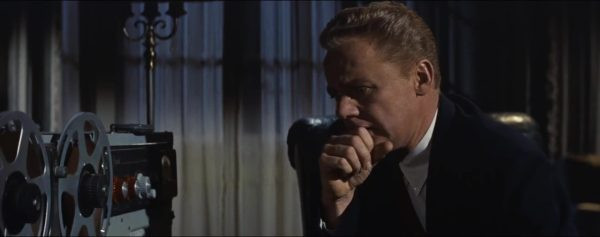For a change of pace from films laden with heavy symbolism, sometimes a tightly crafted mystery thriller is exactly what’s needed. 23 Paces to Baker Street (1956) fits this bill perfectly. It’s an engaging, solid film that prioritizes entertainment with an intriguing plot and strong performances from its cast and crew. This movie carves its niche within a select group of films, alongside titles like The Spiral Staircase, Rear Window, and Wait Until Dark, where the central character navigates a mystery while living with a disability. Far from being exploitative, the disability in 23 Paces to Baker Street serves to heighten the suspense and, ironically, underscore the protagonist’s resilience and ingenuity against the antagonists.

Adapted from a novel by Philip MacDonald, renowned for his mystery novels such as The Rasp and The List of Adrian Messenger, 23 Paces to Baker Street centers on Phillip Hannon (played by Van Johnson), an American playwright residing in London. Hannon is blind, a consequence of an unspecified accident, a misfortune that has understandably contributed to his somewhat sharp-edged personality. This is quickly established when his solitude is disrupted by the arrival of Jean Lennox (Vera Miles), a former love. Her visit stirs up poignant memories of happier times. Perhaps driven by a need to reassert his independence, Hannon ventures out alone to a nearby pub. This outing marks the beginning of the mystery at the heart of 23 Paces to Baker Street. Seated in a pub booth, Hannon inadvertently overhears fragments of a hushed conversation emanating from the adjacent lounge bar. His blindness prevents him from visually identifying the speakers, a man and a woman, but the snippets he catches are enough to ignite his suspicion that a sinister plot, possibly an abduction, is being hatched.
Hannon’s disability immediately becomes a central obstacle. A direct investigation is impossible, and when he approaches the police, they are dismissive, interpreting the fragmented dialogue as ambiguous and inconclusive. Undeterred, Hannon, along with Jean and his resourceful butler, Mr. Grovening (Cecil Parker), embarks on an amateur investigation. Piece by piece, through a blend of fortunate breaks and persistent sleuthing, they begin to assemble a compelling body of evidence. The narrative tension in 23 Paces to Baker Street steadily escalates, culminating in a gripping climax reminiscent of Rear Window, where Hannon cleverly utilizes his blindness to outmaneuver his adversaries.

The brilliance of 23 Paces to Baker Street lies in how it leverages the protagonist’s blindness. This physical limitation isn’t merely a gimmick; it’s integral to sustaining viewer engagement. Hannon’s blindness demands inventive storytelling and scripting, forcing both the character and the narrative to find unconventional solutions. In contrast to stories where law enforcement effortlessly resolves crimes with vast resources, 23 Paces to Baker Street fosters empathy for the “underdog” protagonist. Hannon’s struggle makes him a more compelling and relatable figure.
Henry Hathaway’s direction in 23 Paces to Baker Street is characteristically polished and efficient. Given the protagonist’s limited mobility, the film is largely set in interior locations, a choice that perfectly suits the narrative’s focus. While the widescreen scope format excels at capturing expansive outdoor scenes, Hathaway masterfully utilizes composition to create equally impactful visuals within confined spaces. A palpable sense of tension permeates the film, punctuated by moments of well-placed levity. A notable example is the comedic interlude where Hannon dispatches his butler to tail a suspect. Cecil Parker injects a delightful comedic touch into this pursuit, and his subsequent reports provide welcome lighter moments amidst the suspense.
Van Johnson delivers a nuanced performance as Phillip Hannon. He effectively portrays the character’s fluctuating moods, oscillating between frustration and determination, mirroring the ebb and flow of the investigation. Johnson’s portrayal of blindness is largely convincing, with only a few moments in the climax feeling slightly less authentic. Vera Miles, as Jean Lennox, is somewhat constrained by a character that occasionally leans into clichés. However, this is more a reflection of the writing than Miles’s performance. The supporting cast of 23 Paces to Baker Street is a treasure trove of accomplished British character actors. Alongside Cecil Parker, the film features Maurice Denham, Estelle Winwood, Patricia Laffan, and Liam Redmond, who delivers a memorable, darkly humorous portrayal of an assassin, reminiscent of Edmund Gwenn in Foreign Correspondent.
23 Paces to Baker Street, a 20th Century Fox production, remains surprisingly elusive on DVD in both the US and UK markets. While a Spanish DVD release reportedly exists, the Australian release by Bounty Films, issued recently, offers a readily accessible option. Though a barebones disc with no extras, the Australian DVD presents a commendable transfer. The film is presented in its correct anamorphic widescreen aspect ratio, and while lacking restoration, the transfer is free of significant flaws. Colors are vibrant, the transfer is progressive, and the disc is reasonably priced. The only minor quibble with the presentation is the somewhat misleading branding as part of the “Bounty Noir Classics” line, as 23 Paces to Baker Street is fundamentally a classic mystery thriller, not a film noir.
Ultimately, 23 Paces to Baker Street is a thoroughly entertaining, slick, and briskly paced thriller that grips the viewer from its opening scene to its satisfying conclusion. It earns a strong recommendation as a classic mystery well worth discovering.
